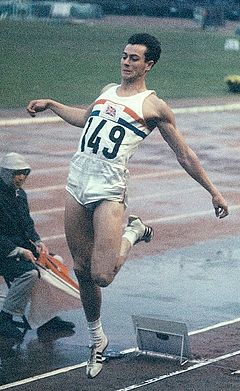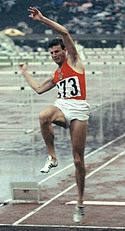Lekkoatletyka na Letnich Igrzyskach Olimpijskich 1964 – skok w dal mężczyzn
 Podium medalistów. Od lewej: Ralph Boston, Lynn Davies i Igor Ter-Owanesian | |
Skok w dal mężczyzn podczas XVIII Letnich Igrzysk Olimpijskich w Tokio rozegrano 18 października 1964 (kwalifikacje i finał) na Stadionie Olimpijskim w Tokio. Zwycięzcą został Brytyjczyk Lynn Davies, który niespodziewanie pokonał faworyta, obrońcę tytułu mistrzowskiego z igrzysk olimpijskich w Rzymie Amerykanina Ralpha Bostona.
Rekordy
| zawodnik | narodowość | wynik | data | miejsce | |
|---|---|---|---|---|---|
| Rekord świata | Ralph Boston | 8,34 | 12 września 1964(dts) | Los Angeles[1] | |
| Rekord olimpijski | 8,12 | 2 września 1960(dts) | Rzym[2] |
Wyniki
| Poz. - pozycja |
| DNF – nie ukończył | DNS – nie wystartował | DSQ – zdyskwalifikowany | NM – Brak zaliczonej odległości |
Kwalifikacje
Do finału awansowali zawodnicy, którzy osiągnęli minimum 7,60 m, względnie 12 najlepszych (gdyby mniej niż 12 zawodników osiągnęło minimum).
| Poz. | Zawodnik | Reprezentacja | #1 | #2 | #3 | Rezultat | Uwagi |
|---|---|---|---|---|---|---|---|
| 1. | Ralph Boston | 8,03 | – | – | 8,03 | Q | |
| 2. | Lynn Davies | 7,39 | x | 7,78 | 7,78 | Q | |
| 3. | Igor Ter-Owanesian | 7,78w | – | – | 7,78w | Q | |
| 4. | Gayle Hopkins | 7,67 | – | – | 7,67 | Q | |
| 5. | Wariboko West | 7,62w | – | – | 7,62w | Q | |
| 6. | Wolfgang Klein | 7,59 | x | 7,54 | 7,59 | q | |
| 7. | John Morbey | x | x | 7,56 | 7,56 | q | |
| 8. | Michael Ahey | 7,21 | 7,26 | 7,53 | 7,53 | q | |
| 9. | Jean Cochard | 6,96 | x | 7,52 | 7,52 | q | |
| 10. | Luis Felipe Areta | 7,31w | 7,46w | 7,34 | 7,46w | q | |
| 11. | Andrzej Stalmach | 7,27 | 7,46 | x | 7,46 | q | |
| 12. | Hiroomi Yamada | x | 7,46 | x | 7,46 | q | |
| 13. | Pentti Eskola | 7,43 | 7,35 | x | 7,43 | ||
| 14. | Antanas Vaupšas | 7,43w | x | x | 7,43w | ||
| 15. | Łeonid Barkowski | 7,30w | 7,39 | x | 7,39 | ||
| 16. | Sunday Akpata | x | x | 7,34w | 7,34w | ||
| 17. | Rajczo Conew | x | 7,33 | 7,29w | 7,33 | ||
| 18. | Hans-Helmut Trense | 7,09 | 7,20 | 7,30 | 7,30 | ||
| 19. | Wellesley Clayton | 6,75 | x | 7,28 | 7,28 | ||
| 20. | Koro Kawazu | 7,28 | x | x | 7,28 | ||
| 21. | Klaus Beer | x | 7,25 | 7,27 | 7,27 | ||
| 22. | Fred Alsop | 7,26 | x | x | 7,26 | ||
| Phil Shinnick | x | 7,26w | x | 7,26w | |||
| 24. | Alain Lefèvre | 6,77w | x | 7,24 | 7,24 | ||
| 25. | Dimitrios Manglaras | 7,06 | 7,11 | 7,21 | 7,21 | ||
| 26. | Satoshi Takayanagi | 7,15 | x | x | 7,15 | ||
| 27. | Ian Tomlinson | 7,07 | x | x | 7,07 | ||
| 28. | Henrik Kalocsai | 6,94 | 6,99 | x | 6,99 | ||
| 29. | B. V. Satyanarayan | x | 6,76 | x | 6,76 | ||
| 30. | Samuel Cruz | x | 6,74w | 6,72w | 6,74w | ||
| 31. | Chu Ming | 6,41 | x | 4,91 | 6,41 | ||
| – | Iftikhar Shah | x | x | x | NM |
Finał
| Poz. | Zawodnik | Reprezentacja | Próby | Wynik | Uwagi | |||||
|---|---|---|---|---|---|---|---|---|---|---|
| 1 | 2 | 3 | 4 | 5 | 6 | |||||
| 1. | Lynn Davies | 7,45 | x | 7,59 | 7,78 | 8,07 | 7,74 | 8,07 | ||
| 2. | Ralph Boston | 7,76 | 7,95 | 7,62 | 7,88 | x | 8,03 | 8,03 | ||
| 3. | Igor Ter-Owanesian | 7,78 | x | 7,64 | 7,80 | 7,99 | 7,81 | 7,99 | ||
| 4. | Wariboko West | 7,56 | 7,51 | 7,50 | 7,40 | 7,60 | x | 7,60 | ||
| 5. | Jean Cochard | x | x | 7,44 | 7,43 | 7,26 | 7,10 | 7,44 | ||
| 6. | Luis Felipe Areta | 7,20 | 7,31 | 7,34 | 5,16 | x | 6,99 | 7,34 | ||
| 7. | Michael Ahey | 6,99 | 7,00 | 7,30 | – | – | – | 7,30 | ||
| 8. | Andrzej Stalmach | 7,26 | 7,10 | x | – | – | – | 7,26 | ||
| 9. | Hiroomi Yamada | 6,94 | x | 7,16 | – | – | – | 7,16 | ||
| 10. | Wolfgang Klein | 7,06 | 7,13 | 7,15 | – | – | – | 7,15 | ||
| 11. | John Morbey | 7,09 | 6,91 | 6,77 | – | – | – | 7,09 | ||
| – | Gayle Hopkins | x | x | x | – | – | – | NM | ||
Przypisy
- ↑ Progression of IAAF World Records. 2015 Edition, IAAF, 2015, s. 174 [dostęp 2020-09-05] (ang.).
- ↑ Mark Butler (red.): IAAF Statistics Handbook Special Edition. Games of the XXXI Olympiad Rio 2016. IAAF, 2016, s. 153–154. [dostęp 2020-09-05]. (ang.)
- ↑ Janusz Waśko, John Brant, Györgyi Csiki, Andrzej Socha: Golden Century of IAAF Records. National Records Evolution 1912-2012. Zamość: 2013, s. 115. ISBN 978-83-62033-30-0. (ang.)
Bibliografia
- Athletics at the 1964 Tokyo Summer Games: Long Jump, Men, olympedia.org [dostęp 2020-09-05] (ang.).
Media użyte na tej stronie
An icon that represents a gold medal
An icon that represents a silver medal
The flag of Navassa Island is simply the United States flag. It does not have a "local" flag or "unofficial" flag; it is an uninhabited island. The version with a profile view was based on Flags of the World and as a fictional design has no status warranting a place on any Wiki. It was made up by a random person with no connection to the island, it has never flown on the island, and it has never received any sort of recognition or validation by any authority. The person quoted on that page has no authority to bestow a flag, "unofficial" or otherwise, on the island.
An icon that represents a bronze medal
Sport records icon to be used for world records.
Sport records icon to be used for national records.
Sport records icon to be used for personal best marks.
Sport records icon to be used for season's best marks.
Sport records icon to be used for Olympic records.
Flag of the unified Team of Germany for the Olympic Games, 1960–1968.
Autor: SanchoPanzaXXI, Licencja: CC BY-SA 4.0
Flag of Spain during the Spanish State. It was adopted on 11 October 1945 with Reglamento de Banderas Insignias y Distintivos (Flags, Ensigns and Coats of Arms Bill)
Variant version of a flag of Japan, used between January 27, 1870 and August 13, 1999 (aspect ratio 7:10).
Flaga Finlandii
Autor: Scroch, Licencja: CC BY-SA 4.0
National Flag of the People's Republic of Bulgaria (1948-1967). Tha flag has got the coat-of-arms from 1948
Autor: Scroch, Licencja: CC BY-SA 4.0
National Flag of the People's Republic of Bulgaria (1948-1967). Tha flag has got the coat-of-arms from 1948
Flag of Jamaica. “The sunshine, the land is green, and the people are strong and bold” is the symbolism of the colours of the flag. GOLD represents the natural wealth and beauty of sunlight; GREEN represents hope and agricultural resources; BLACK represents the strength and creativity of the people. The original symbolism, however, was "Hardships there are, but the land is green, and the sun shineth", where BLACK represented the hardships being faced.
The Flag of India. The colours are saffron, white and green. The navy blue wheel in the center of the flag has a diameter approximately the width of the white band and is called Ashoka's Dharma Chakra, with 24 spokes (after Ashoka, the Great). Each spoke depicts one hour of the day, portraying the prevalence of righteousness all 24 hours of it.
Pictograms of Olympic sports – . This is an unofficial sample picture. Images of official Olympic pictograms for 1948 Summer Olympics and all Summer Olympics since 1964 can be found in corresponding Official Reports.
Lynn Davies, 1964 Olympics
Igor Ter-Ovanesyan, 1964 Olympics
Ralph Boston, Tokyo 1964
Ralph Boston, Lynn Davies, Igor Ter-Ovanesyan, 1964 Olympics




























